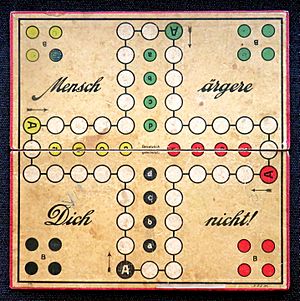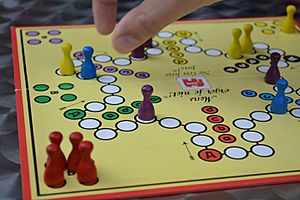Mensch ärgere Dich nicht facts for kids
 |
|
| Designer(s) | Josef Friedrich Schmidt |
|---|---|
| Publisher(s) | Schmidt Spiele |
| Publication date | 1914 |
| Genre(s) | Board game |
| Language(s) | German |
| Players | 2 to 4 (2 to 6 on reverse side) |
| Setup time | 1 minute |
| Playing time | about 30 minutes |
| Random chance | High (die rolling) |
| Skill(s) required | Counting, probability |
Mensch ärgere Dich nicht (pronounced "Mench AIR-guh-ruh Dish Nicht") is a super popular German board game. Its name means "Man, Don't Get Angry!" This fun game was created by Josef Friedrich Schmidt in Germany around 1907-1908.
Since it first came out in 1914, over 70 million copies have been sold! It's played in many countries across Europe. This game is a type of "cross and circle" game. It's quite similar to other games you might know, like Ludo, Sorry!, or Parcheesi.
Contents
How to Play Mensch ärgere Dich nicht
This game is usually played by 2, 3, or 4 players. Some special versions let up to 6 players join in. Each player gets four game pieces. At the start, these pieces are in your "out" area, waiting to enter the game.
The game board has rows arranged like a cross. These rows are connected by a circle of fields. Your game pieces move around this circle in a clockwise direction.
Setting Up the Board
Each side of the board has three main fields.
- The "out" area (marked "B" in some versions) is where your pieces begin.
- Your "start" field (marked "A") is where your pieces enter the main circle.
- Your "home" row (marked "a", "b", "c", "d") is where your pieces need to end up.
The goal is to be the first player to get all four of your pieces safely into your "home" row.
Taking Your Turn
Players take turns rolling a game die. You move any of your pieces forward by the number shown on the die.
Rolling a Six
If you roll a six, you get to do two things:
- You can bring a new piece from your "out" area onto your "start" field.
- You get to roll the die again!
If you have a piece on your "start" field and other pieces still in the "out" area, you must move that piece as soon as possible. If you can't bring a piece into play, you must move another piece you already have on the board, if possible. A common rule lets you roll the die three times if you don't have any pieces on the main board yet, hoping for a six.
Moving and Sending Pieces Back
Your pieces can jump over other pieces on the board. If your piece lands on a field already occupied by another player's piece, you can send their piece back! That piece goes all the way back to their "out" area. They'll have to roll a six to get it back into the game.
You cannot send your own pieces back. Even if you land on your own piece, nothing happens. A piece can be sent back even if it's on its "start" field.
Different Ways to Play
There's another version of the game called Verliere nicht den Kopf (which means Don't lose your head). It uses the same basic rules but has a couple of cool differences:
- When a piece lands on a corner square, it can take a special shortcut on its next move. This lets you save time getting around the board.
- To finish the game in this version, you need to roll the exact number to land your pieces on specific spots in your "home" row. For example, your first piece needs to land on the very last square, your second piece on the second to last, and so on. In the original game, you can move pieces within the "home" row even if your roll is too high, which means your piece stays on the board longer and has a higher chance of being sent back!
See also
 In Spanish: Mensch ärgere Dich nicht para niños
In Spanish: Mensch ärgere Dich nicht para niños


